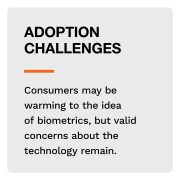 State and federal lawmakers are beginning to pass legislation regulating the collection and processing of biometric data. However, the burden goes beyond complying with the law, as both customers and business partners increasingly demand that businesses prove compliance with data privacy and other regulations to ensure their data is safe.
State and federal lawmakers are beginning to pass legislation regulating the collection and processing of biometric data. However, the burden goes beyond complying with the law, as both customers and business partners increasingly demand that businesses prove compliance with data privacy and other regulations to ensure their data is safe.
In the June edition of the “Alternative Payments Tracker®,” PYMNTS explores how organizations utilize technology to help verify the identities of those with whom they do business. It also explores the regulatory requirements that will shape the future of how those technologies are deployed.
Around the Alternative Payments Space
A large majority of Canadian consumers are concerned about control over their personal information collected by government entities. A recent survey found that many would support the use of a secure, unified digital ID system. Due to shifts caused by the pandemic, about half of Canadians are more comfortable using digital methods for conducting transactions. At the same time, two-thirds said they would feel more comfortable with a secure and private digital ID to help them do it safely.
 Meanwhile, some 90% of U.S. companies are not prepared to meet the requirements of California data privacy and protection laws that are expected to go into full effect on Jan 1, 2023, according to a recent report. The California Consumer Privacy Act (CCPA) and the California Privacy Rights Act (CPRA) require that companies doing business with residents of the state comply with regulations giving these consumers more control over how their data is collected and used.
Meanwhile, some 90% of U.S. companies are not prepared to meet the requirements of California data privacy and protection laws that are expected to go into full effect on Jan 1, 2023, according to a recent report. The California Consumer Privacy Act (CCPA) and the California Privacy Rights Act (CPRA) require that companies doing business with residents of the state comply with regulations giving these consumers more control over how their data is collected and used.
For more on these stories, visit the Tracker’s News and Trends section.
Zil Money on the Challenges of Digital Identity Verification for FIs
Banks and FinTechs that handle the financial livelihoods of their customers must be sure who they are doing business with or risk losing not only large sums of money but also their clients’ trust and future business. Consumers increasingly want to be able to use their mobile devices to do their banking, but as hackers learn how to get around safeguards, financial institutions (FIs) are more challenged than ever. Digital verification will play a major role in the future of financial services, and the evolution of security technology will depend on both experimentation and individual adoption by FIs.
In this month’s Feature Story, Justin Timlin, chief operating officer of Michigan-based FinTech Zil Money, talks about how digital account verification will affect how FIs do business and the challenges they face as consumers increase their use of mobile devices to transact business.
PYMNTS Intelligence: Complying With Digital Identity Verification Regulations
 As technology removes the human element from authentication efforts in favor of electronic means such as biometrics, the potential for data breaches and fraud has increased. Data breaches were a top worry for 69% of consumers in a recent survey, followed by 62% who said the invasion of privacy was a concern. Identity theft is on the rise, and the number of U.S. adults affected by traditional identity fraud grew to 15 million victims in 2021, up by more than half from 2020.
As technology removes the human element from authentication efforts in favor of electronic means such as biometrics, the potential for data breaches and fraud has increased. Data breaches were a top worry for 69% of consumers in a recent survey, followed by 62% who said the invasion of privacy was a concern. Identity theft is on the rise, and the number of U.S. adults affected by traditional identity fraud grew to 15 million victims in 2021, up by more than half from 2020.
As governments continue to pass regulations designed to protect consumer data, corporate leaders need to focus on achieving compliance if they hope to avoid penalties and erosion of public trust. Companies that expect customers to trust them with their data need to ensure they do all they can to protect their customers. This month’s PYMNTS Intelligence takes a close look at how regulators are putting pressure on corporate entities to comply with legislation designed to protect consumers’ data.
About the Tracker
The “Alternative Payments Tracker®,” a PYMNTS and Socure collaboration, examines how organizations utilize technology to help verify the identities of those with whom they do business. It also explores the regulatory requirements that will shape the future of how those technologies are deployed.

 As the world becomes more connected and the number of digital devices used to conduct business continues to grow, organizations are under more pressure than ever to know with whom they are doing business. Customers, however, have waning tolerance for cumbersome identity verification processes, giving rise to the use of technologies such as biometrics that offer less friction than traditional passwords and usernames in authenticating users’ identities.
As the world becomes more connected and the number of digital devices used to conduct business continues to grow, organizations are under more pressure than ever to know with whom they are doing business. Customers, however, have waning tolerance for cumbersome identity verification processes, giving rise to the use of technologies such as biometrics that offer less friction than traditional passwords and usernames in authenticating users’ identities.





